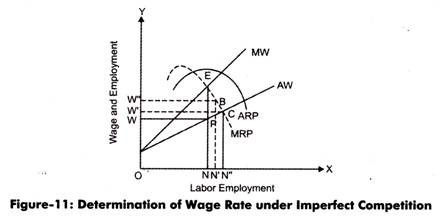Economists, such as Joan Robinson and Pigou, have contributed a lot in determining wages in imperfect competition.
There can be various forms of an imperfect market, including monopolistic competitive market, oligopoly, and monopoly.
Here, we will focus our discussion of wage determination in context of monopsony. In case of monopsony, there is only one buyer of a factor of production, which is labor in this case. This single buyer has no competitor in the market.
Therefore, the position of the buyer is very strong as compared to labor. Monopsony can also take place when a single employer employs a huge labor force for a particular job type. In this case, the employer would have a control on setting the wages for that particular job.
ADVERTISEMENTS:
Figure-11 shows the determination of wage rate in case of imperfect competition:
In Figure-11, AW (average wage curve) is representing the supply curve of labor, while MRP represents the demand curve of labor. AW is showing an upward slope. This implies that employer needs to pay higher wages if he/she wants to hire more labor. MW represents the marginal wage curve.
MW intersects MRP at point E, which is the equilibrium point. At point E, MW gets equal to MRP when the number of labor is equal to ON with the wage rate of OW (=NH). The wage rate OW is lower than the MRP wage rate that is NE. Therefore, the labor is getting wage rate lower by EH from the actual MRP rate that they deserve.
ADVERTISEMENTS:
EH represents the level of wage rate at which labor is exploited in monopsony condition. It is also termed as monopsonistic exploitation. Therefore, in case of monopsony, the wage rate and number of employees is low as compared to perfect competition. In case of perfect competition, the equilibrium point would be at C. At point C, wage rate would be OW (=NC) and number of labor is ON that is higher as compared to the case of monopsony.
